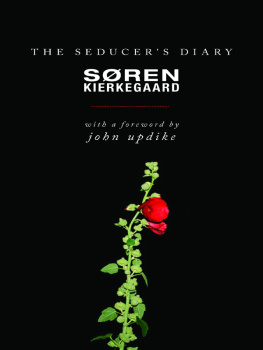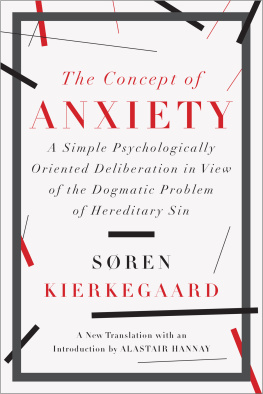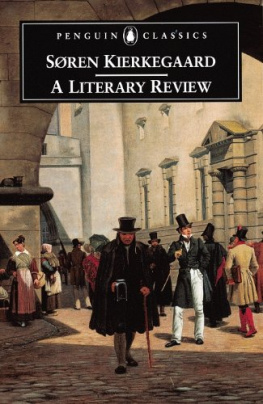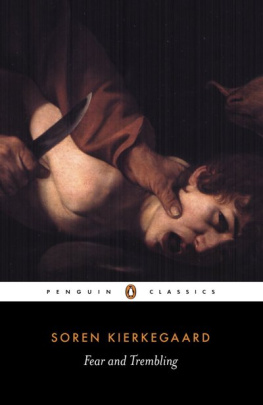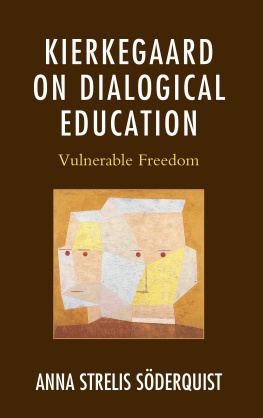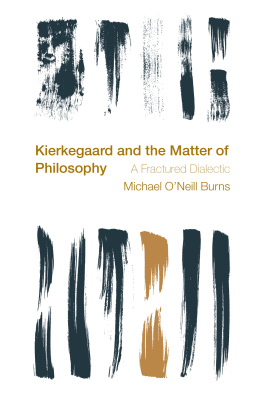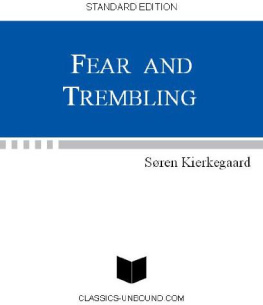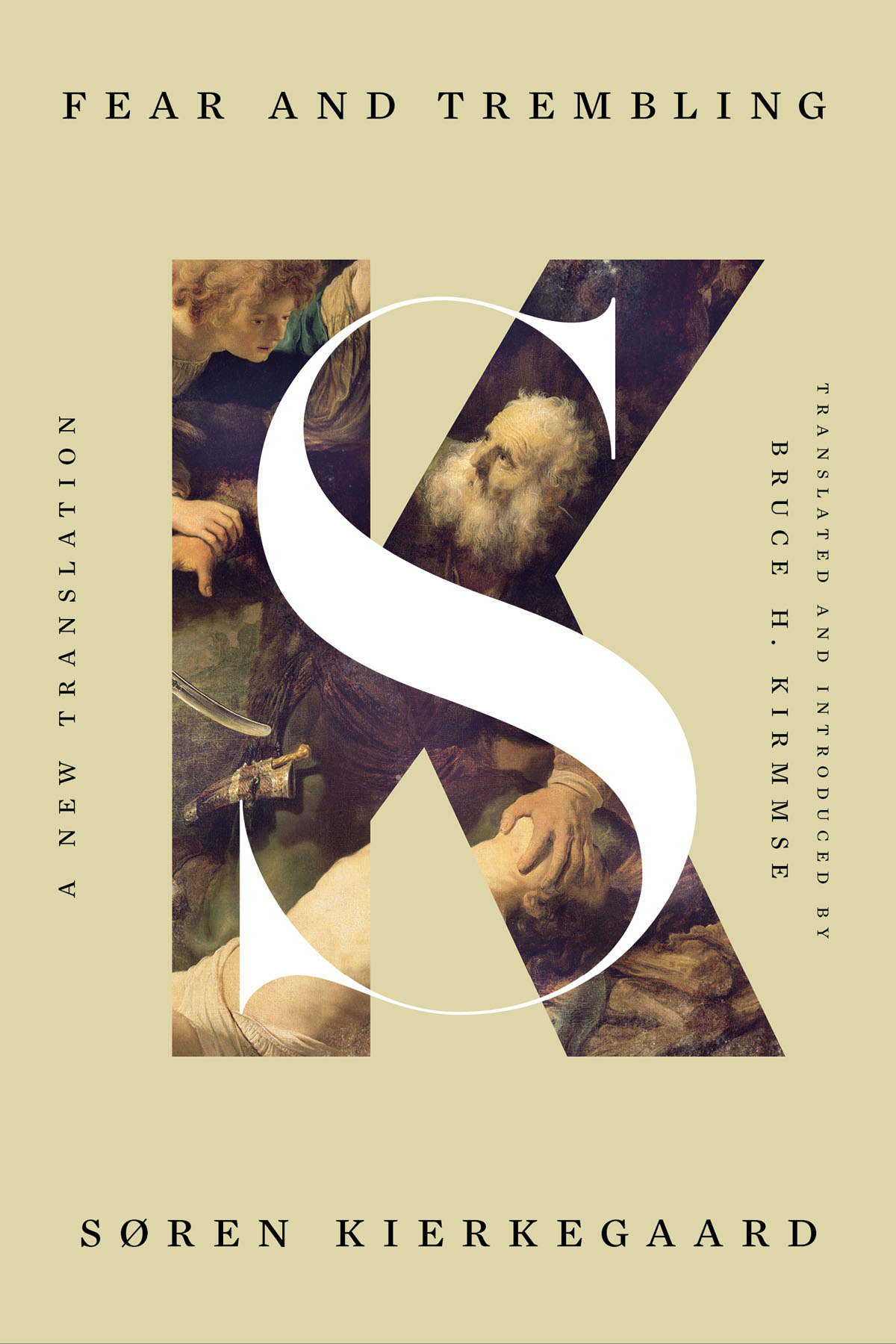Contents
Guide
Page List
Sren Kierkegaard
Fear and Trembling
A NEW TRANSLATION

TRANSLATED AND INTRODUCED BY
Bruce H. Kirmmse

Liveright Publishing Corporation
A DIVISION OF W. W. NORTON & COMPANY
INDEPENDENT PUBLISHERS SINCE 1923
For my family, on both sides of the Atlantic.
CONTENTS
Fear and Trembling,
A G UIDE TO AN U NKNOWN C OUNTRY
A T THE OUTSET of Fear and Trembling, Johannes de silentio , the putative author, cites a passage from the eighteenth-century German philosopher Johann Georg Hamann, which recounts the story of a cryptic, nonverbal message that the early Roman king Tarquin the Proud instructed a messenger to communicate to his son, Sextus Tarquinius. The son understood the message, though the messenger did not, and it is clear, both from this epigraph and from the name de silentio , that Sren Kierkegaard, the actual author, intended the entire book to be a message of the same sort.
Let us therefore tease forth the meanings in the book. First, we must investigate and acknowledge the well-known autobiographical thread that runs through the work, and following that, we will survey the substantive argument that is also present in Fear and Trembling.
In September 1849, a bit less than six years after the publication, in October 1843, of the dialectical lyric Fear and Trembling, which he attributed to one Johannes de silentio , Kierkegaard wrote this entry in his journal:
Ah, some day after I am dead, Fear and Trembling alone will be enough to immortalize my name as an author. Then it will be read and translated into foreign languages. People will practically shudder at the frightful emotion in the book. But at the time it was written, when the person who was believed to be its author went about in the incognito of a flaneur, looking like the very soul of roguishness, wit, and frivolity, no one could really grasp the seriousness. Ah, you fools, the book was never as serious as it was then. That itself is the true expression of the horror. Had the author appeared to be serious, the horror would have been less. The reduplication is what is monstrous in the horror.
But when I am dead, people will form an imagined figure of me, a dark figureand the book will be terrifying.
But the book itself has already said something true by pointing out the difference between the poet and the hero. There is a predominantly poetic element within me, but Fear and Trembling contains a deliberate mystification, namely that it actually reproduced my own life. The book was already hinted at in this fashion in the intimation of it that can be found in the oldest journal, the one in octavo, that is, the oldest journal from my time as an author.
Kierkegaard seems to boast of having obscured the autobiographical element in the work. But in fact, Fear and Trembling is, if anything, altogether too obvious about its secrets. Anyone with just a bit of knowledge of Kierkegaards life and his fateful and painful break with his fiance, Regine Olsen, can easily find hints that allow, or even encourage, the reader to view the book in the same way that many have read The Diary of the Seducer in Kierkegaards earlier blockbuster, Either/Or (published in February 1843)namely, as a roman clef, starring Kierkegaard as the (apparent) villain and his fiance as the (equally apparent) victim. The supposed incognito of Kierkegaards fictive author, Johannes de silentio , is almost embarrassingly transparent, and yet Kierkegaard boasts about his deliberate mystification. Kierkegaard was certainly right about the brilliance and importance of the book, but he was very much mistaken if he believed that the book had successfully concealed the fact that it actually reproduced my own life, because the autobiographical vein mentioned above has been mined extensively by many subsequent investigators.
In the passage cited above, from his 1849 journal, Kierkegaard refers to an entry in the oldest journal from my time as an author, a journal he designated JJ. The entry in question, JJ:87, is from April 1843, about six months prior to the publication of Fear and Trembling. The bulk of this entry consists of a version of what came to be the first of the four brief variations on the Abraham/Isaac story that Kierkegaard was to include in the preliminary section of Fear and Trembling. Following the portion of the entry that could be mistaken for a draft of a page from that section, Kierkegaard permitted himself this aside:
But where, after all, is the contemporary poet who has a sense for such collisions? And yet Abrahams conduct was truly poetic, magnanimous, more magnanimous than everything I have read of in tragedies. When the child is to be weaned, the mother blackens her breast, but her eye looks upon the child just as lovingly. The child believes that it is the breast that has changed, but the mother is unchanged. And this is why she blackens the breast, because she says that it would be a shame for it to look so inviting when the child must not have it. This collision is easily resolved, because the breast is only a part of the mother herself. Fortunate the person who did not experience more terrible collisions; who did not need to blacken himself; who did not need to travel to hell in order to learn what the Devil looks likeso that he could depict himself like that and thus, if possible, save another human being, at least in his or her relation to God. This would be Abrahams collision. The person who explains this mystery has explained my life. But who among my contemporaries has understood this?
Here again, it certainly does not take much of a sleuth to detect portions of a self-portrait in Kierkegaards Fear and Trembling. In Golden Age Copenhagen, pseudonyms (such as Johannes de silentio ) were both commonly used and usually transparent. Kierkegaards contemporary readers were familiar both with his scandalous conduct toward his fiance and with his perhaps less than 100 percent successful attempt to repel her by appearing to be a rogue and a dandy. Moreover, Kierkegaard was certain that his voluminous journals and notebooks would be published after his death, and he took care to preserve them for the future, deleting only those limited portions that he wished to keep truly private. Thus 1869, a mere fourteen years after Kierkegaards death, saw the publication of the first volume of what have become several increasingly inclusive editions of his private journals and notebooks. If, in the 1840s, there were some readers who did not recognize autobiographical elementsincluding, especially, the parallel between Abrahams willingness to sacrifice Isaac and Kierkegaards sacrificing his engagement to Regine Olsenfrom the 1860s onward, almost no careful and informed reader of Kierkegaard could fail to recognize them. Therefore, in the present translation of Fear and Trembling the reader will not fail to recognize them, either.
Nonetheless, having seen through Kierkegaards rather unambitious effort to protect his supposed incognito, his autobiographical presence, in Fear and Trembling, we must also appreciate that the book is very much more than a philosophical roman clef. Therefore, after acknowledging and bearing in mind the autobiographical elements in the book, the most important thing is to address the much more important unknown that dominates the book, an unknown that is of far greater significance than mere authorial/autobiographical hide-and-seek.



